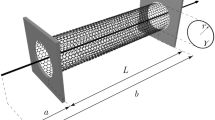Abstract
Stress relaxation in a nano-sized rod containing structural defects in the course of constant-rate uniaxial straining is studied, and the reasons for the onset of this phenomenon are determined. Under the assumption that structural defects can serve as carriers of irreversible strain of a higher level than dislocations, the problem is solved by the molecular dynamics method. It is found that stress relaxation is accompanied by the transition of the entire system to a steady state with a deeper potential minimum as compared to the system energy before the stress relaxation process, resulting in a temperature increase and reduction of the strain tensor components.
Similar content being viewed by others
References
G. I. Kanel, E. B. Zaretsky, S. V. Razorenov, et al. “Evolutions of Elastic-Plastic Shock Compression Waves in Different Materials,” AIP Conf. Proc. 1793, 100030 (2017).
N. R. Barton, J. V. Bernier, R. Becker, et al., “A Multiscale Strength Model for Extreme Loading Conditions,” J. Appl. Phys. 109, 073501 (2011).
G. Z. Voyiadjis and F. H. Abed, “Microstructural Based Models for bcc and fcc Metals with Temperature and Strain Rate Dependency,” Mech. Materials 37(2/3), 355–378 (2005).
N. S. Selyutina and Yu. V. Petrov, “Prediction of the Dynamic Yield Stress of Metals with the Use of Two Structural-Temporal Parameters,” Fiz. Tverd. Tela 60 (2), 240–244 (2018).
L. A. Merzhievskii and S. A. Shamonin, “Construction of the Time Dependence of the Relaxation of Tangential Stresses on the State Parameters of a Medium,” Prikl. Mekh. Tekh. Fiz. 21 (5), 170–179 (1980) [J. Appl. Mech. Tech. Phys. 21 (5), 716–724 (1980)].
M. S. Voronin, “Simplified Method of Calculating the Parameters of the Relaxation Time of the Shear Stress by an Example of Polymers,” Vychisl. Met. Program. 18 (2), 146–157 (2017).
V. M. Kosenkov, “Determination of Relaxation and Dislocation Characteristics of Metals on the Basis of Shock Compression Diagrams,” Prikl. Mekh. Tekh. Fiz. 55 (4), 33–42 (2014) [J. Appl. Mech. Tech. Phys. 55 (4), 578–585 (2014)].
V. S. Krasnikov, A. Yu. Kuksin, A. E. Maier, and A. V. Yanilkin, “Plastic Deformation in High-Velocity Loading of Aluminum: Multiscale Approach,” Fiz. Tv. Tela 52 (7), 1295–1304 (2010).
S. Groh, E. B. Marin, M. F. Horstemeyer, and H. M. Zbib, “Multiscale Modeling of the Plasticity in an Aluminum Single Crystal,” Int. J. Plast. 25 (8), 1456–1473 (2009).
Y. Xu-Sheng, W. Yun-Jiang, W. Guo-Yong, et al., “Time, Stress, and Temperature-Dependent Deformation in Nanostructured Copper: Stress Relaxation Tests and Simulations,” Acta Mater. 108, 252–263 (2016).
Z. Tomasz and C. Dariusz, “Stress Induced Grain Boundaries in Thin Co Layer Deposited on Au and Cu,” Appl. Phys. A: Mater. Sci. Proces. 122 (10), 908 (2016).
Q. Qingquan, Y. Sheng, Ch. Guangming, et al., “Recoverable Plasticity in Penta-Twinned Metallic Nanowires Governed by Dislocation Nucleation and Retraction,” Nature Comm. 6, 5983 (2015).
A. F. Voter, “Embedded Atom Method Potentials for Seven FCC Metals: Ni, Pd, Pt, Cu, Ag, Au, and Al,” Tech. Report No. LA-UR 93–3901 (Los Alamos National Laboratory, Los Alamos, 1993).
E. I. Golovneva, I. F. Golovnev, and V. M. Fomin, “Modeling of Quasi-Static Processes in Crystals by the Molecular Dynamics Method,” Fiz. Mezomekh. 6 (6), 5–10 (2003).
Author information
Authors and Affiliations
Corresponding author
Additional information
Original Russian Text © I.F. Golovnev, E.I. Golovneva, M.S. Voronin, E.R. Pruuel.
Translated from Prikladnaya Mekhanika i Tekhnicheskaya Fizika, Vol. 60, No. 4, pp. 111–118, July–August, 2019.
This work was supported by the Russian Foundation for Basic Research (Grant No. 16-01-00468).
Rights and permissions
About this article
Cite this article
Golovnev, I.F., Golovneva, E.I., Voronin, M.S. et al. Numerical Study of Stress Relaxation in Nanostructures in the Course of Uniaxial Straining. J Appl Mech Tech Phy 60, 685–691 (2019). https://doi.org/10.1134/S0021894419040126
Received:
Revised:
Accepted:
Published:
Issue Date:
DOI: https://doi.org/10.1134/S0021894419040126




